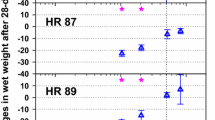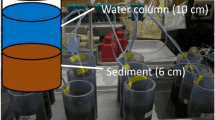Abstract
The complex and variable composition of natural sediments makes it difficult to predict the bioavailability and bioaccumulation of sediment-bound contaminants. Several approaches, including an experimental model using artificial particles as analogues for natural sediments, have been proposed to overcome this problem. For this work, we applied this experimental device to investigate the uptake and bioaccumulation of AsIII by the freshwater oligochaete Lumbriculus variegatus. Five different particle systems were selected, and particle–water partition coefficients for AsIII were calculated. The influence of different concentrations of commercial humic acids was also investigated, but this material had no effect on bioaccumulation. In the presence of particulate matter, the bioaccumulation of AsIII by the oligochaetes did not depend solely on the levels of chemical dissolved but also on the amount sorbed onto the particles and the strength of that binding. This study confirms that the use of artificial particles may be a suitable experimental model for understanding the possible interactions that may occur between contaminants and particulate matter. In addition, it was found that the most hydrophobic resin induced an increase in arsenic bioavailability, leading to the highest bioaccumulation to L. variegatus compared with animals that were exposed to water only.



Similar content being viewed by others
References
Agency for Toxic Substances Disease Registry (2007) Toxicological profile for arsenic. Public Health Service, ATSDR, Atlanta, GA
American Public Health Association–American Water Works Association–Water Pollution Control Federation (2005) Standards methods for the examination of water and wastewater, 21th ed. APHA–AWWA–WPCF, Baltimore, MD
American Society for Testing Materials (2010) Standard test methods for measuring the toxicity of sediment-associated contaminants with fresh water invertebrates (ASTM E1706–00). Annual Book of ASTM Standards Volume 11.05. American Society for Testing and Materials, West Conshohocken, PA
Burgess RM, McKinney RA (1999) Importance of interstitial, overlying water and whole sediment exposures to bioaccumulation by marine bivalves. Environ Pollut 104:373–382
Carter DE, Aposhian HV, Gandolfi AJ (2003) The metabolism of inorganic arsenic oxides, gallium arsenide, and arsine: a toxicological review. Toxicol Appl Pharmacol 193:309–334
Caussy D (2003) Case studies of the impact of understanding bioavailability: arsenic. Ecotoxicol Environ Safe 56:164–173
Choong TSY, Chuah TG, Robiah Y, Gregory Koay FL, Azni I (2007) Arsenic toxicity, health hazards and removal techniques from water: an overview. Desalination 217:139–166
Conrad AU, Comber SD, Simkiss K (2000) New method for the assessment of contaminant uptake in the oligochaete Lumbriculus variegatus. Bull Environ Contam Toxicol 65:16–21
Davies NA, Taylor MG, Simkiss K (1997) The influence of particle surface characteristics on pollutant metal uptake by cells. Environ Pollut 96:179–184
Dawson TD, Lott KG, Leonard EN, Mount DR (2003) Time course of metal loss in Lumbriculus variegatus following sediment exposure. Environ Toxicol Chem 22:886–889
Di Rienzo JA, Casanoves F, Balzarini MG, Gonzalez L, Tablada M, Robledo CW (2008) InfoStat, versión 2008, Grupo InfoStat. FCA, Universidad Nacional de Córdoba, Argentina
Fattorini D, Regoli F (2004) Arsenic speciation in tissues of the Mediterranean polychaete Sabella spallanzanii. Environ Toxicol Chem 23:1881–1887
Fattorini D, Notti A, Halt MN, Gambi MC, Regoli F (2005) Levels and chemical speciation of arsenic in polychaetes: a review. Mar Ecol 26:255–264
Haitzer M, Höss S, Traunspurger W, Steinberg C (1998) Effects of dissolved organic matter (DOM) on the bioconcentration of organic chemicals in aquatic organisms – a review. Chemosphere 37:1335–1362
Hughes MF (2002) Arsenic toxicity and potential mechanisms of action. Toxicol Lett 133:1–16
Karadjova IB, Slaveykova VI, Tsalev DL (2008) The biouptake and toxicity of arsenic species on the green microalga Chlorella salina in seawater. Aquat Toxicol 87:264–271
Koopal LK, van Riemsdijk WH, Kinniburgh DG (2001) Humic matter and contaminants. General aspects and modeling metal ion binding. Pure Appl Chem 73:2005–2016
Landrum PF, Robbins JA (1990) Bioavailability of sediment-associated contaminants to benthic invertebrates. In: Baudo R, Giesy JP, Muntau H (eds) Sediments: chemistry and toxicity of in-place pollutants. Lewis, Chelsea, pp 237–263
Leppänen MT, Kukkonen JVK (1998) Relationship between reproduction, sediment type, and feeding activity of Lumbriculus variegatus (Müller): implications for sediment toxicity testing. Environ Toxicol Chem 17:2196–2202
Ley Nº 24051 (1992) Ley Nacional de Residuos Peligrosos: Normas para los Vertidos de Establecimientos Industriales o Especiales alcanzados por el Decreto 674/89, República Argentina
Mandal BK, Suzuki KT (2002) Arsenic round the world: a review. Talanta 58:201–235
Michel P, Chiffoleau JF, Averty B, Auger D, Chartier E (1999) High resolution profiles for arsenic in the Seine Estuary. Seasonal variations and net fluxes to the English Channel. Cont Shelf Res 19:2041–2061
Millward GE, Kitts HJ, Ebdon L, Allen JI, Morris AW (1997) Arsenic species in the Humber Plume. UK Cont Shelf Res 17:435–454
Mount DR, Dawson TD, Burkhar LP (1999) Implications of gut purging for tissue residues determined in bioaccumulation testing of sediment with Lumbriculus variegatus. Environ Toxicol Chem 18:1244–1249
Mount DR, Highland TL, Mattson VR, Dawson YD, Lott KG, Ingersoll CG (2006) Use of the oligochaete, Lumbriculus variegatus, as a prey organism for toxicant exposure of fish through the diet. Environ Toxicol Chem 25:2760–2767
Nice AI, Lung WS, Riedel GF (2008) Modeling arsenic in the Patuxent estuary. Environ Sci Technol 42:4804–4810
Norwood WP, Borgmann U, Dixon DG (2007) Chronic toxicity of arsenic, cobalt, chromium and manganese to Hyalella azteca in relation to exposure and bioaccumulation. Environ Pollut 147:262–272
Notti A, Fattorini D, Razzetti EM, Regoli F (2007) Bioaccumulation and biotransformation of arsenic in the Mediterranean polychaete Sabelle spallanzanii: Experimental observations. Environ Toxicol Chem 26:1186–1191
Pawlik-Skowrónska B, Pirszel J, Kalinowska R, Skowroński T (2004) Arsenic availability, toxicity and direct role of GSH and phytochelatins in As detoxification in the green alga Stichococcus bacillaris. Aquat Toxicol 70:201–212
Pedlar RM, Klaverkamp JF (2002) Accumulation and distribution of dietary arsenic in lake whitefish (Coregonus clupeaformis). Aquat Toxicol 57:153–166
Schulten HR, Plague B, Schnitzer MA (1991) A chemical structure for humic substances. Naturwissenschaften 78:311–312
Sharma VK, Sohn M (2009) Aquatic arsenic: toxicity, speciation, transformations, and remediation. Environ Int 35:743–759
Simkiss K, Edwards PA, Lawrence MAM, Davies NA, Taylor MG (2000) The use of hydrophobic resins as analogues for sediment testing. Environ Sci Technol 34:2388–2392
Simkiss K, Davies NA, Edwards PA, Lawrence MAM, Taylor MG (2001) The use of sediment analogues to study the uptake of pollutants by chironomid larvae. Environ Pollut 115:89–96
Thomas DJ, Styblo M, Lin S (2001) The cellular metabolism and systemic toxicity of arsenic. Toxicol Appl Pharmacol 176:127–144
United States Environmental Protection Agency (2000) Methods for measuring the toxicity and bioaccumulation of sediment-associated contaminants with freshwater invertebrates, 2nd ed. EPA/600/R-99/064. USEPA, Washington, DC
Verrengia Guerrero NR (1995) Contaminantes metálicos en el Río de La Plata: Monitoreo del sistema acuático y estudio de algunos efectos tóxicos en moluscos bivalvos por medio de bioensayos. Doctoral thesis, University of Buenos Aires, Buenos Aires, Argentina
Verrengia Guerrero NR (2007) Predicting the uptake and bioaccumulation of organic pollutants from natural sediments. In: Plattenberg RH (ed) Environmental pollution: new research. Nova Science, New York, NY, pp 141–184
Verrengia Guerrero NR, Nahabedian DE, Wider EA (2000) Analysis of some factors that may modify the bioavailability of cadmium and lead by Biomphalaria glabrata. Environ Toxicol Chem 19:2779–2787
Verrengia Guerrero NR, Taylor MG, Wider EA, Simkiss K (2001) Modeling pentachlorophenol (PCP) bioavailability and bioaccumulation by the freshwater fingernail clam Sphaerium corneum using artificial particles and humic acids. Environ Toxicol Chem 20:2910–2915
Verrengia Guerrero NR, Taylor MG, Wider EA, Simkiss K (2003) Influence of particle characteristics and organic matter content on the bioavailability and bioaccumulation of pyrene by clams. Environm Pollut 121:115–122
Verrengia Guerrero NR, Taylor MG, Simkiss K (2007) Modelling 2,4-dichlorophenol bioavailability and bioaccumulation by the freshwater fingernail clam Sphaerium corneum using artificial particles and humic acids. Environ Pollut 145:238–244
Ward JE, Levinton JS, Shumway SE, Cucci T (1998) Site of particle selection in a bivalve mollusk. Nature 390:131–132
Acknowledgments
This work was supported by Grant No. X-233 from the University of Buenos Aires. We also thank Valot S.A. for providing some materials and INTEMIN-SEGEMAR, Argentina, for collaborating with arsenic determinations.
Author information
Authors and Affiliations
Corresponding author
Rights and permissions
About this article
Cite this article
Nasi, M., Piol, M.N., Di Risio, C. et al. Investigating Arsenic Bioavailability and Bioaccumulation by the Freshwater Oligochaete Lumbriculus variegatus . Arch Environ Contam Toxicol 61, 426–434 (2011). https://doi.org/10.1007/s00244-010-9639-6
Received:
Accepted:
Published:
Issue Date:
DOI: https://doi.org/10.1007/s00244-010-9639-6




